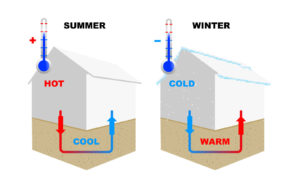Mankind has used the relatively constant temperature of the shallow Earth for climate control for thousands of years with structures like root cellars and caves. Energy from the Earth has been used to heat and air condition buildings using mechanical heat pumps for decades, and during that time these systems have been called many different things. Some of the most common variations include geothermal heat pump, ground source heat pump and geoexchange. So how are these different? Well, they really are not. All of these names are meant to describe essentially the same thing. The process that these names describe is the movement of heat from the ground into a building for heating and the movement of heat from a building into the ground for cooling using a heat pump.
Why not just use one name?
One name would make things simpler but that is probably not going to happen right away. What should we call the highest efficiency, lowest operating cost and most climate friendly way to heat and cool commercial buildings and residences? I think we can call it anything we want. There are people who wrinkle their noses if someone says ‘geothermal’ instead of ‘ground source heat pump’ or ‘geoexchange’ but I don’t put much weight in nose wrinkling. As a professional I believe all three names are good but imperfect.

- ‘Geothermal Heat Pump’ is the most common name but also the most maligned. On the most basic technical level it is correct because we are working with earth (geo) heat (thermal) using a heat pump. There is the potential to confuse geothermal heat pumps with high temperature geothermal energy. The biggest problem with this is when someone starts to think they need to live on the slope of a volcano to heat their building geothermally. In dealing with clients, I find that simply ‘Geothermal’ or just ‘Geo’ is the most common name for what we do in public use and this has become my most used name.
- ‘Ground Source Heat Pump’ is a technically correct option that I find second most common after ‘geothermal’. I use ‘GSHP’ nearly as often as I do ‘Geothermal’ and think it is a fine choice that helps avoid visions of volcanos. One problem is that GSHP is the common term for the equipment and does not stress the underground component as well as Geothermal does.
- ‘GeoExchange’ is my least favorite but I won’t wrinkle my nose when it is used. GeoExchange may be the most technically accurate of the three choices here. GeoExchange refers to the entire process of using the GSHP in conjunction with the underground (or underwater) heat exchanger. I think this term was coined in an effort to market geothermal heat pump technology and differentiate it from high temperature geothermal energy projects. For me, GeoEchange does not roll of the tongue and I don’t hear many clients using the term.
In truth, none of the three is a perfect naming choice. The issue will resolve itself over time. In the end, I just wish for more people to use and think about any (or all) of the names. Heating and cooling using the treasure under our feet is important to energy policy and the more it is talked about the better. Whatever name you use, you are still talking about using the heat stored in the Earth to save 60-75% of HVAC operating cost and reduce HVAC carbon footprint by the same 60-75%.





